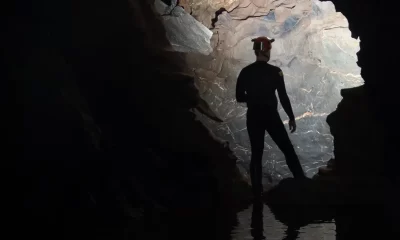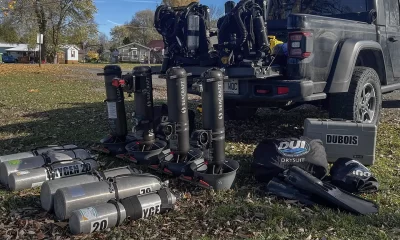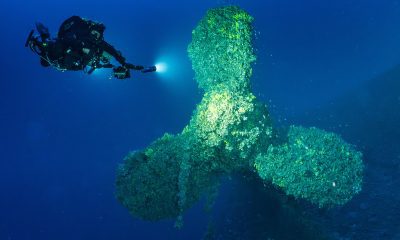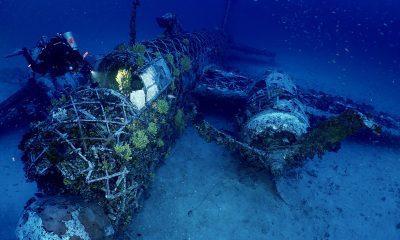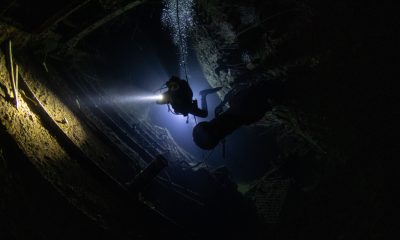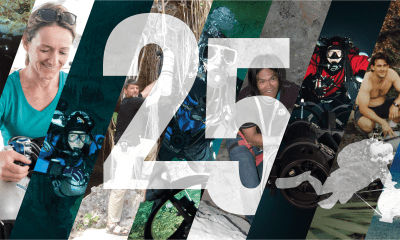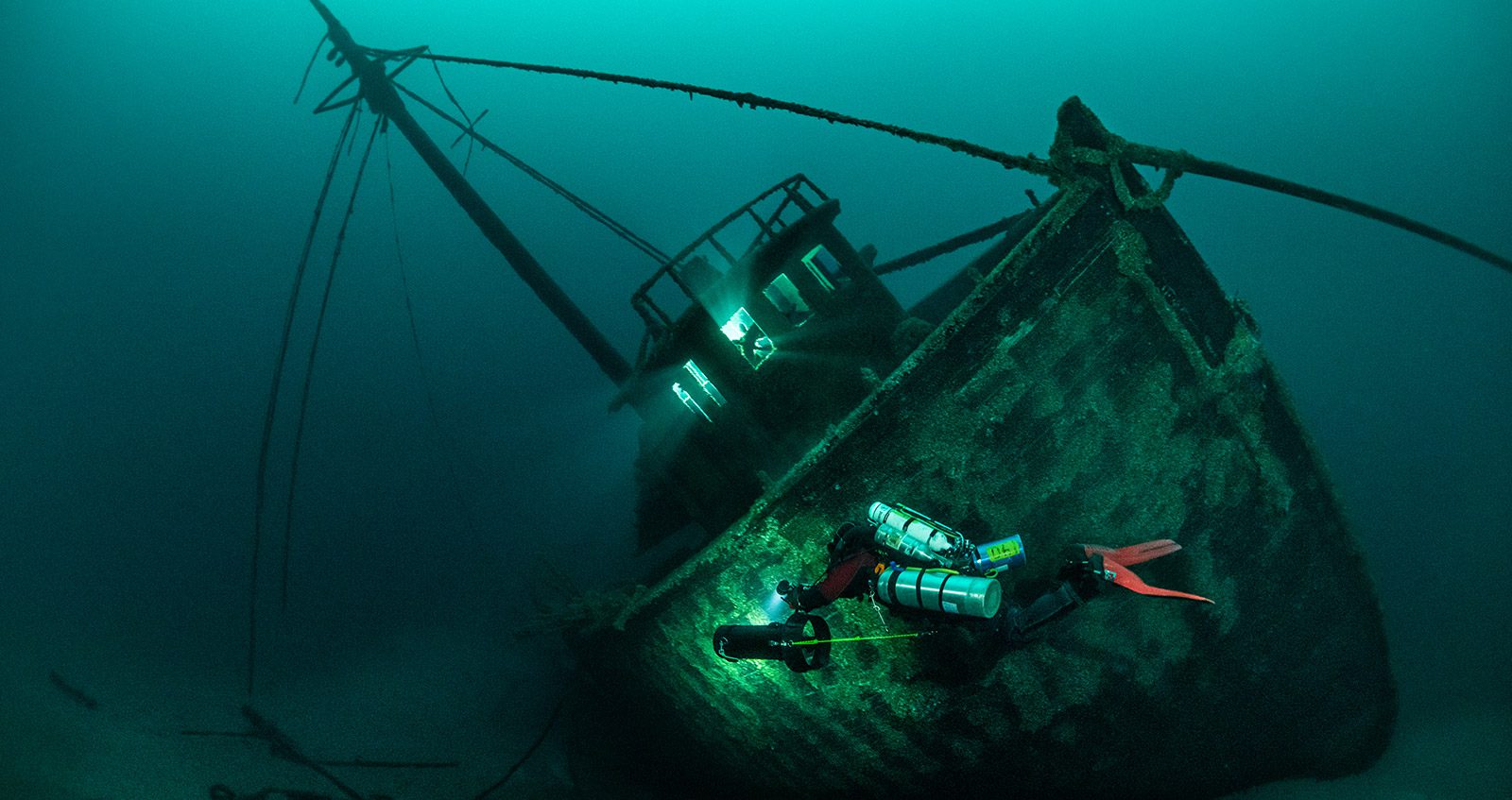
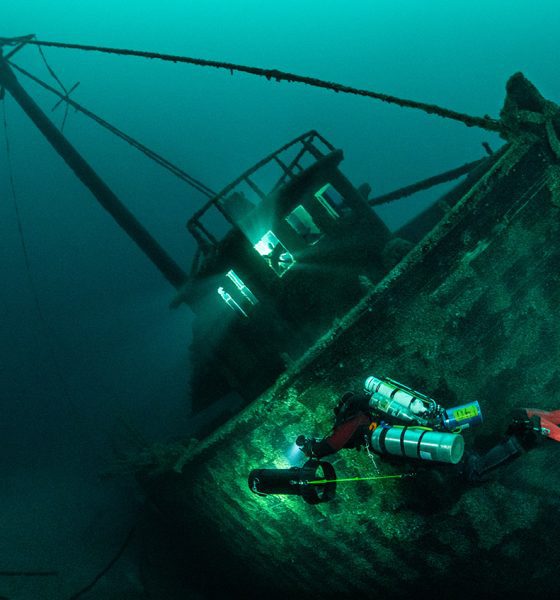
Latest Features
An Ice Water Museum Named SS Ohio
Shipwreck photographer Jeff Lindsay takes us on a dive to the recently discovered wreck of the Great Lakes bulk freighter SS Ohio, which sits nearly upright in 92 m/300 ft depth in Lake Huron’s Thunder Bay National Marine Sanctuary. The fresh, nearly-freezing water has turned the failed freighter into what Lindsay describes as a sunken ice water museum. Who’s packing the heat?
Text and photography by Jeff Lindsay
The fully loaded bulk freighter SS Ohio headed south into the open waters of Lake Huron. Wind and waves began to build, which was not out of the ordinary for an early autumn morning in 1894—nothing the 19-year-old Ohio hadn’t seen before. By midday, another steamship was spotted towing two schooners north, also a common occurance on the Lakes. As the two steamers were passing each other, the steamship’s tow line broke, sending one of the schooners directly into the path of the SS Ohio.
Bulk freighters do much of the world’s shipping—transporting materials that permit the conveniences of modern life. Grain, coal, stone, and ores play roles that are as important in our society today as they were 150 years ago. Shipping these materials is the specialty of the bulk freighter, and they’re still a common sight on the Great Lakes. Today, these giant steel ships are over 305 m/1,000 ft long and carry 54,431 metric tons/60,000 US tons in one trip. Years ago, these ships were much smaller, but their purpose was no less important.

The SS Ohio was an early design in the evolution of the Great Lakes bulk freighter. Made of sturdy oak and just over 60 m/200 ft long, she was launched in 1875 and immediately went into service. Powered by a single steam engine, her three masts provided a level of redundancy should the engine fail.
The Ohio was carrying a full cargo of grain from Duluth, Minnesota, to the lower lakes on her final voyage. The course took her across the entire width of Lake Superior, down the Saint Mary’s River, and into the steel blue waters of Lake Huron. Nearing Presque Isle, Michigan,—an area notorious for rough weather and busy shipping lanes—they encountered the steamer Kershaw that was towing two schooners: Moonlight and Ironton. In a case of the worst possible timing, the tow line separated when the ships were directly opposite each other, causing the Ironton to crash into the side of the Ohio. As the two ships were pulled apart by the wind and waves, water poured into the breach. The captain of the Ohio realized his ship was mortally wounded and ordered the crew to lower lifeboats and abandon ship. Thirty minutes later, Lake Huron added two more vessels to her private collection.

Finding the Ohio
Today, the waters off Presque Isle are part of the Thunder Bay National Marine (TBNM) Sanctuary, and they encompass some of the most spectacular shipwreck diving the Great Lakes has to offer. Thunder Bay estimates its 11,000 sq km/4,300 sq mi sanctuary contains more than 200 shipwrecks, about half of which have been discovered so far. To put this in perspective, the Bermuda Triangle is over 2.6 million sq km/1 million sq mi and contains 30-70 shipwrecks. The Ohio was located and positively identified inside the TBNM sanctuary in 2017.
Dedicated search teams continue the hunt for missing shipwrecks every summer on the Great Lakes. The discovery of the SS Ohio created much excitement, as it was rumored to be somewhat intact and well within reach of established technical profiles. Unlike the regularly dived shipwrecks of Presque Isle, the Ohio was not moored at the time. Locating and installing a down-line is part of the planning that goes into these types of “off the grid” dives. The additional preparation and effort to visit the Ohio added to the allure of this stunning vessel.
Mid-summer often presents an ideal weather window for diving in this area; thermoclines can reach down to 18 m/60 feet, permitting comfortable decompression after experiencing bottom temperatures between 2-4 °C/35-39 °F. During July 2022, our team had beautiful summer conditions to complete several dives to the deck of the SS Ohio.
Any long descent is always filled with anticipation—time spent staring into the abyss, willing the shipwreck to come into view. With the depth on our computers steadily increasing, we dropped past 45 m/150 ft; the visibility instantly cleared, and the entire wreck materialized. A further 45 m/150 ft beneath us, draped in shadows, lay the remains of a 19th century museum, the SS Ohio.
The Ohio rests just over 92 m/300 ft deep, upright and listing to starboard. The collision damage from the Ironton’s bow is immediately apparent on the port side, just forward of the Scotch Marine boiler. The aft cabins have collapsed, exposing the steam engine, but otherwise she is exquisitely intact. Two of the three masts remain standing, their rigging reaching down to the lake floor, reminding me of tangled vines in a jungle. As my eyes adjusted to the dim light, dark shadows and silhouettes toyed with my imagination. Fine details slowly came into view. Railings and portholes seem freshly painted, thick deck planks are straight and true with only a fine layer of silt and mussels.
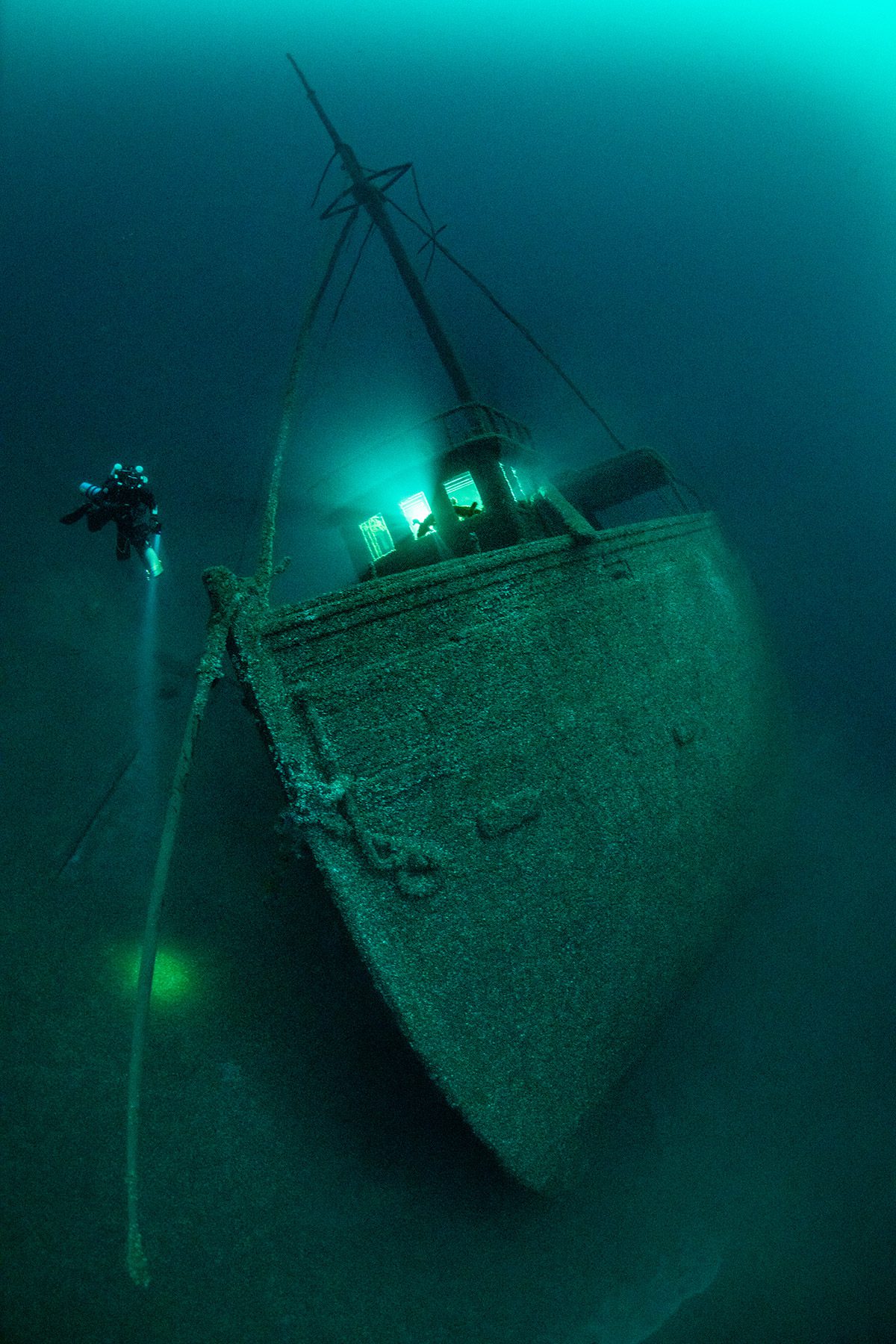
Up Close and Personal
My dive buddy, Bob Larson, had agreed to limit our bottom time to only 25 minutes to explore this treasure, so we moved with purpose towards the bow. Making our way forward past the stern cabins, we quickly looked inside open doors and spotted the single boiler within, gauges still unbroken. Continuing overtop of the open cargo holds, we reached the bow, looking unchanged since her sinking 128 years ago. It’s rare to see an intact wheelhouse on a wooden shipwreck, as it often separates from the hull during sinking.
The Ohio’s wheelhouse is, simply put, perfect. The large wooden double wheel fills the pilot house. The handles look as though they were recently used, adding to the supernatural feel of this wreck. Moving off the starboard side, down to the lake bottom, presented a stunning silhouette, and we could almost make out the entire 61 m/202 ft of this ghost ship in the fading light. Artifacts—including an intact glass barometer and running lights—are scattered across the deck.
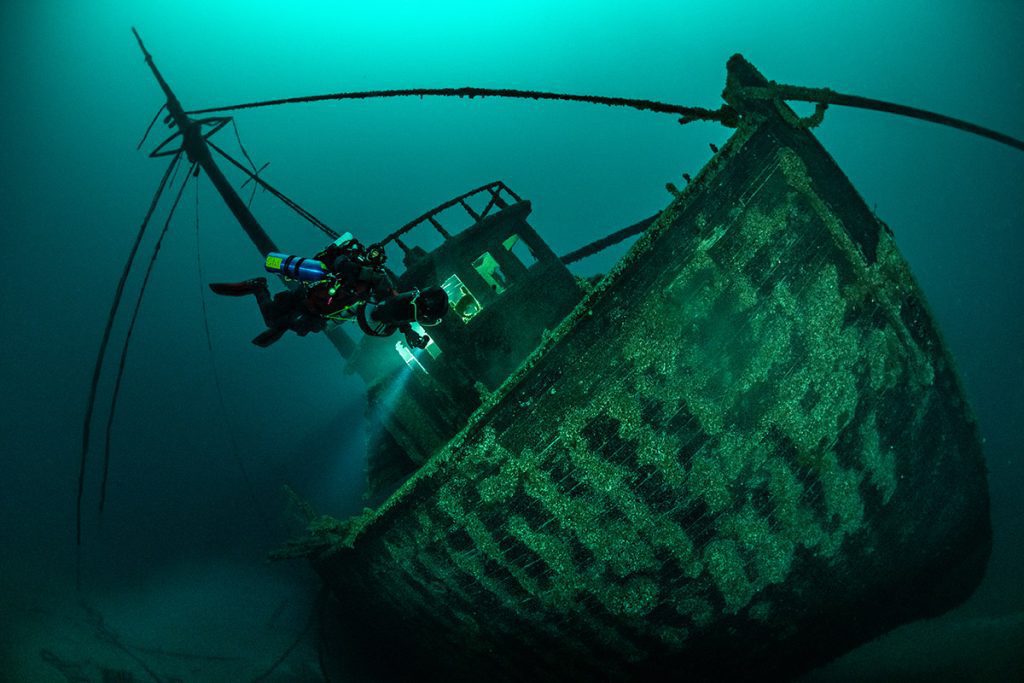
Self-preservation reminded us to begin our return to the upline where we spotted the fallen smokestack, looking as though it was placed gently on the lakebed.
With a lengthy decompression schedule ahead of us, we were permitted time to reflect on what we just witnessed. “Haunting beauty” is the only way I can describe it. The Ohio is a working freighter frozen in time, giving us a glimpse of life in the late 19th century—a reminder that the mundane task of transporting materials we all use presents a real danger for the people who sail these ships. What’s most striking to me is how peaceful the Ohio looks resting on the bottom. Perhaps it was the buoyant cargo of grain that allowed her to settle so gently? So many other wrecks appear to have crashed into the lake floor, instead the Ohio seems to be softly cradled by it.
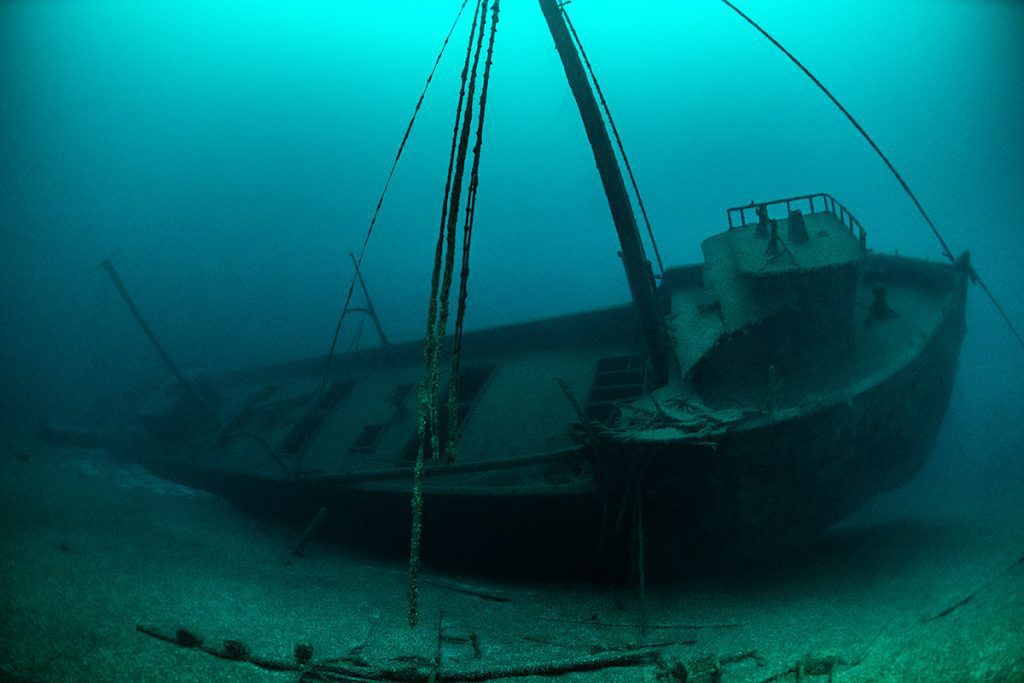
Fortunately, the entire crew of the SS Ohio was rescued by the Moonlight and taken ashore: cold, wet, and in disbelief of their bad luck.
Underscoring the danger of travel on the Lakes, the Moonlight went to the bottom of Lake Superior nine years after rescuing the crew of the Ohio, but that’s another story.
As for the Ironton, she suffered the worst loss. Five people perished in the incident, including the captain. She was reported to have sunk the same time as the SS Ohio; but, to this day, no trace of her has ever been found.
Several dive charters operate out of Presque Isle Harbor, but due to the spectacular shipwrecks in this area, reservations are required well in advance. The wreck diving here is considered intermediate to extended range, from 52 m/170 ft to well over 91 m/300 ft. For this reason—along with cold water and sometimes rough waves—it’s recommended to complete workup dives ahead of time and prepare yourself for a visit to the ice water museum of Lake Huron!
DIVE DEEPER
Thunder Bay Marine Sanctuary: Ohio
InDEPTH: Picturing Shipwreck History by Becky Schott
InDEPTH: Lake Erie Technical Wreck Diving Guide: A Necessary Tool by Gene Peterson

Growing up on the shores of the Great Lakes fostered a natural curiosity of the unexplored for Jeff Lindsay; learning to dive in 1990 led to a lifelong desire to visit and photograph the unknown and forgotten. With an almost limitless number of shipwrecks nearby, a natural progression into technical diving was required for the deeper and more remote locations. He’s been invited on numerous projects as team photographer around the world as well as being a keynote speaker at Diving Talks, Portugal. His biggest thrill is still visiting a shipwreck or cave and capturing some small part of its essence in a photograph. His website: www.jefflindsay.ca



















